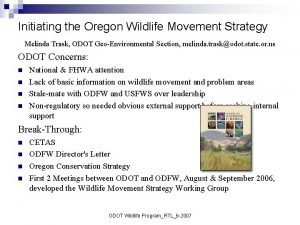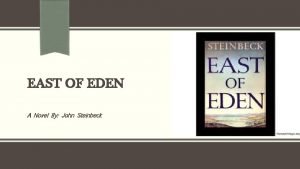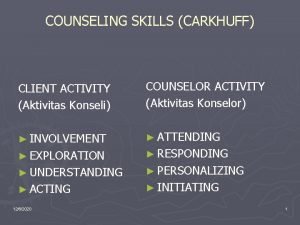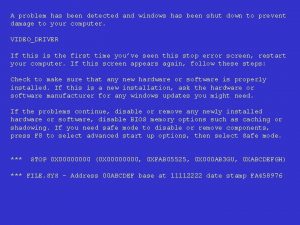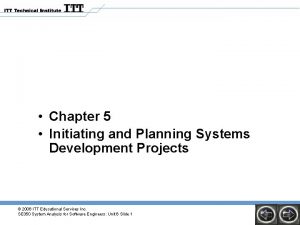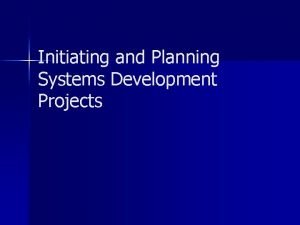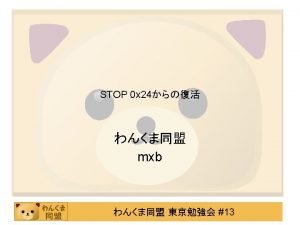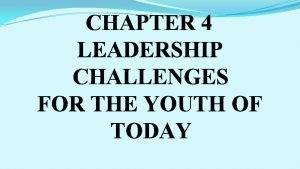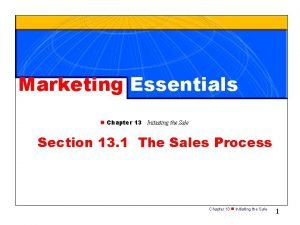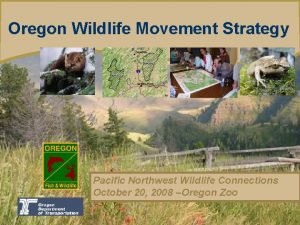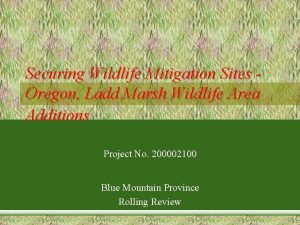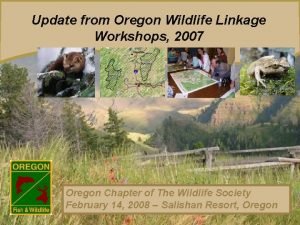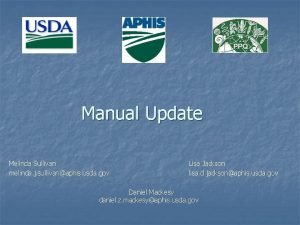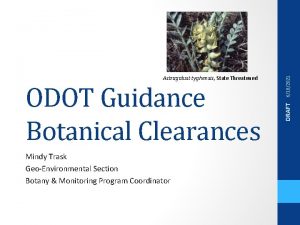Initiating the Oregon Wildlife Movement Strategy Melinda Trask










- Slides: 10

Initiating the Oregon Wildlife Movement Strategy Melinda Trask, ODOT Geo-Environmental Section, melinda. trask@odot. state. or. us ODOT Concerns: n n National & FHWA attention Lack of basic information on wildlife movement and problem areas Stale-mate with ODFW and USFWS over leadership Non-regulatory so needed obvious external support before seeking internal support Break-Through: n n CETAS ODFW Director's Letter Oregon Conservation Strategy First 2 Meetings between ODOT and ODFW, August & September 2006, developed the Wildlife Movement Strategy Working Group ODOT Wildlife Program_RTL_6 -2007

(we are here) ODOT Wildlife Program_RTL_6 -2007

Highway Animal-Vehicle Collisions n n n Types of data: crash records, dispatch/carcass reports, maintenance records, focused roadkill surveys, anecdotal reports. Crash records, National: 725, 000 -1, 500, 000 animal-vehicle collisions in the U. S. annually, over 200 human fatalities, over 29, 000 human injuries, & over $1 billion in property damage per year (2003 statistical summary). Crash records, Oregon: avg. 395 collisions/yr with wildlife, past 12 years. ¨ Less than 3% of all crash reports in Oregon. ¨ Approx. 1 to 2 deaths and 8 -10 serious injuries per year. Proportions of deer-vehicle crash records are much higher in the NE states. ¨ In 2003, the Northern Midwest states avg 12. 1% of all crashes involving collisions with deer (Illinois, Iowa, Michigan, Minnesota, Wisconsin). Crash records represent only a small portion of actual animal-vehicle collisions nationally (less than 10% of actual deer-vehicle collisions). Current GES project to map collision hot spots using carcass pick-up records. ODOT Wildlife Program_RTL_6 -2007

Road Kill ≠ (always) Wildlife Movement Area X ODOT Wildlife Program_RTL_6 -2007

ODOT Wildlife Collision Prevention Program n Addressing wildlife passage is supported by ODOT’s current mission and goals, and particularly within the values of safety, accountability, and environmental stewardship. n Current lack of information - we cannot adequately address the problem. ¨ ¨ ¨ n Do we have a significant statewide road kill problem or just some areas? Need to prioritize wildlife movement corridors and highway barrier problem areas to make science-based decisions and cost-effective, versus ad-hoc. ODOT Regions need better tools to adequately address wildlife passage concerns. Non-regulated but supported by FHWA, ODFW, USFWS, CETAS, nationwide attention. ODOT Wildlife Program_RTL_6 -2007

Recommendations for Transportation Projects n n n Evaluate wildlife passage conditions at early project scoping, when relevant. ¨ When is it relevant? "Easy" wildlife passage solutions ¨ Ideas? Wildlife fencing - restrict access or allow access? ? ¨ Constraints? ¨ Best types of fencing? Consider impacts of median barriers and guardrail. ¨ Solution more complicated. ODOT Bios, ODFW Liaisons, ODOT Designers need training on design considerations. ¨ Two-day workshop possibly combined with road ecology conference being proposed for Portland in May 2006. ¨ ODOT manual being developed for scoping, funding, and design considerations. ODOT Wildlife Program_RTL_6 -2007

Critter Crossings Linking Habitats and Reducing Roadkill http: //www. fhwa. dot. gov/environment/wildlifecrossings/intro. htm Keeping It Simple - Easy Ways to Help Wildlife Along Roads ODOT Wildlife Program_RTL_6 -2007

Examples of Wildlife Improvements Amphibian/reptile crossing Culverts high and wide enough for elk Wood toprail along barbed wire fence protects deer Bark mulch berm for stormwater treatment ODOT Wildlife Program_RTL_6 -2007

ODOT Wildlife Program_RTL_6 -2007

Summary n ODOT is Just beginning Tier 1. Need well-informed decisions! ¨ ¨ ¨ ¨ To save $, best to provide wildlife crossings where needed and prioritize. We do not know yet the "state of the problem. " Crash data indicate low priority from a "safety" standpoint relative to other safety hazards (esp. human deaths and injuries). There may be localized hot spots that would be considered a safety hazard. Problem likely to increase as ADT, highway width, human population, deer populations grow. This is non-regulated and currently not well funded. Design solutions are for environmental, public interest, or safety reasons. ODOT Wildlife Program_RTL_6 -2007
 Melinda trask
Melinda trask East of eden trask family tree
East of eden trask family tree Attending responding personalizing initiating
Attending responding personalizing initiating A problem has detected and windows shut down
A problem has detected and windows shut down Initiating and planning systems development projects
Initiating and planning systems development projects Initiating and planning systems development projects
Initiating and planning systems development projects A problem has been detected
A problem has been detected User requirement
User requirement Leadership challenges for the youth of today
Leadership challenges for the youth of today Merchandise approach method
Merchandise approach method Knapp's model of relational stages
Knapp's model of relational stages
